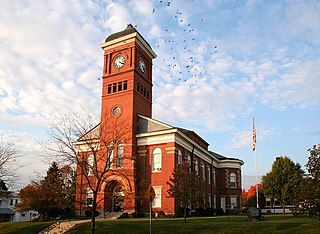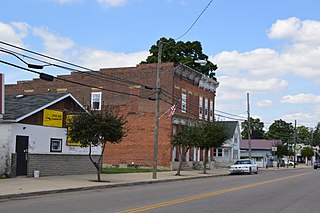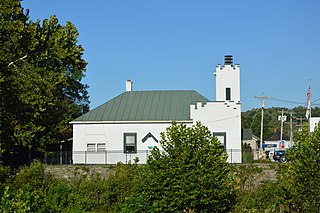
Morrow County is a county located in the central portion of the U.S. state of Ohio. As of the 2020 census, the population was 34,950. Its county seat is Mount Gilead. The county was organized in 1848 from parts of four neighboring counties and named for Jeremiah Morrow who was the Governor of Ohio from 1822 to 1826. Shawnee people used the area for hunting purposes before white settlers arrived in the early 19th century. Morrow County is included in the Columbus, OH Metropolitan Statistical Area. In 2010, the center of population of Ohio was located in Morrow County, near the village of Marengo.

Fulton County is a county located in the U.S. state of Ohio west of Toledo. As of the 2020 census, the population was 42,713. Its county seat and largest city is Wauseon. The county was created in 1850 with land from Henry, Lucas, and Williams counties and is named for Robert Fulton, inventor of the steamboat. Fulton County is a part of the Toledo metropolitan area.

Archbold is a village in Fulton County, Ohio, United States. The population was 4,516 at the 2020 census. Located about 40 miles (64 km) southwest of Toledo, Archbold is home to Northwest State Community College.

Delta is a village in Fulton County, Ohio, United States. The population was 3,316 at the 2020 census.

Fayette is a village in Fulton County, Ohio, United States. The population was 1,305 at the 2020 census.

Lyons is a village in Fulton County, Ohio, United States. The population was 602 at the 2020 census.

Metamora is a village in Fulton County, Ohio, United States. The population was 566 at the 2020 census.

Hamler is a village in Henry County, Ohio, United States. The population was 600 at the 2020 census. Hamler is a rural farming community in Northwest Ohio about 40 miles (64 km) southwest of Toledo, Ohio. It is located at the intersection of the former Baltimore and Ohio (B&O) and former Detroit, Toledo and Ironton railroads and the intersection of Ohio State Route 109 and Ohio State Route 18.

Holgate is a village in Henry County, Ohio, United States. The population was 1,061 at the 2020 census.

Liberty Center is a village in Henry County, Ohio, United States. The population was 1,108 at the 2020 census.

Malinta is a village in Henry County, Ohio, United States. The population was 226 at the 2020 census.

New Bavaria is a village in Henry County, Ohio, United States. The population was 86 at the 2020 census.

Cardington is a village in Morrow County, Ohio, United States. The population was 2,051 at the 2020 census. Mount Gilead, Ohio, the county seat, is located northeast of Cardington on U.S. Route 42.

Chesterville is a village in Morrow County, Ohio, United States, along the Kokosing River. The population was 191 at the 2020 census. Chesterville is southeast of Mount Gilead, the county seat.

Edison is a village in Morrow County, Ohio, United States. The population was 422 at the 2020 census. Edison is adjacent to and west of Mount Gilead, Ohio, the county seat.

Marengo is a village in Morrow County, Ohio, United States. The population was 283 at the 2020 census. Marengo is south of Mount Gilead, the county seat.

Sparta is a village in Morrow County, Ohio, United States. The population was 121 at the 2020 census. Sparta is southeast of Mount Gilead, the county seat.

Fultonham is a village in Muskingum County, Ohio, United States. The population was 115 at the 2020 census. It is part of the Zanesville micropolitan area. Fultonham was named for Robert Fulton, inventor of the first commercially successful steamboat.

Morrow is a village in Salem Township, Warren County, Ohio, United States. The population was 2,049 at the 2020 census.

Matamoras, also known as New Matamoras, is a village in Washington County, Ohio, United States, along the Ohio River. The population was 702 at the 2020 census. It is part of the Marietta micropolitan area.























